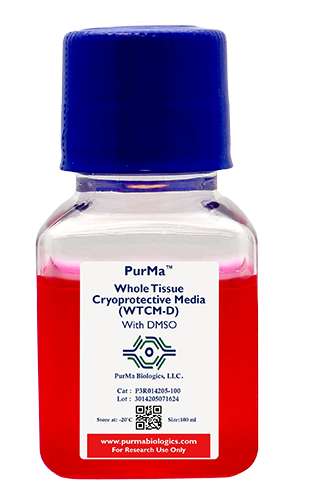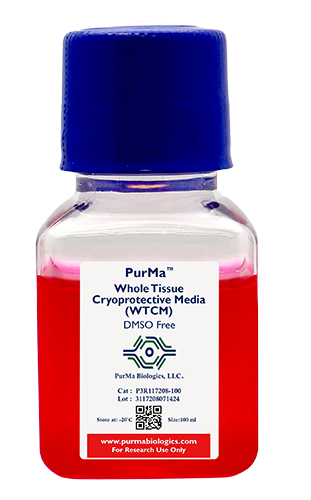Whole Tissue Cryoprotective Media (WTCM-D) with DMSO
Cryopreservation of tissues especially when a big portion is intended to be used is challenging. Additionally, the biggest obstacle is forming ice crystals inside the cells. This inevitably, cause volume expansion with the destruction of cell membranes and holes in loose connective tissue. Whole Tissue Cryoprotective Media (WTCM-D) with DMSO, preserve tissues during rapid freezing. This remarkably promotes formation of amorphous ice ( rather than crystal ice).
Description
Background
Cryopreservation of tissues especially when a big portion is intended to be used is challenging. Additionally, the biggest obstacle is forming ice crystals inside the cells. This inevitably, cause volume expansion with the destruction of cell membranes and holes in loose connective tissue. Whole Tissue Cryoprotective Media (WTCM-D) with DMSO, preserve tissues during rapid freezing. This remarkably promotes formation of amorphous ice ( rather than crystal ice).
PurMa™ WTCM-D has particularly overcome several challenges
- Liquid nitrogen has a low specific heat constant. When it contacts warm tissues or OCT it boils and forms a vapor barrier and acts as an insulator. As a result, the inner core of the tissue sample freezes slowly and unevenly. This is especially more challenging when the tissue sample is large. The cryoprotective agents in PurMa™ WTCM-D precents this to happen by penetrating rapidly inside the tissue.
- PurMa™ WTCM-D acts regardless of the size of the tissue. PurMa™ WTCM has high thermal conductivity. This, therefore, can allow liquid nitrogen for rapid and efficient cryoprotection.
- PurMaTM WTCM contains ingredients which makes it suitable for the preservation of rigid tissues.
Special Features
- Ready-to-Use.
- PurMaTM WTCM provides much higher cell viability after short/long-term cryoprotection,
- PurMaTM WTCM Prevents the formation of crystals in extracellular space. This, consequently, prevents cellular dehydration and resulting in less exposure to toxins from the non-recovering cells.
- Preserves morphological appearance as a standard factor of cell recovery.
- Tested for pH, osmolality, sterility, and endotoxin.
- Each Lot of PurMaTM WTCM is tested for pathogens and sterility. We evaluate each Lot as well for several criteria. Including survival (by Trypan Blue method), viability & performance (by MTT Test), and the recovery rate by Alamar Blue test.
- PurMaTM WTCM has been tested successfully for several commonly used tissue including rodent heart, brain, and kidney.
Guideline
for PurMa Biologics guideline for cryoprotection, click here as well as in corresponding tab: PurMa™ Guideline for Cryoprotecting various cell lines
References
- Diffusion and distribution of dimethyl sulphoxide in the isolated guinea-pig taenia coli. Elford BC. J Physiol. 1970 Jul;209(1):187-208. doi: 10.1113/jphysiol.1970.sp009162.
- Cryopreservation of whole ovine ovaries with pedicles as a model for human: parameters of perfusion with simultaneous saturations by cryoprotectants. Isachenko et al. Clin Lab. 2015;61(3-4):415-20. doi: 10.7754/clin.lab.2014.140919. PMID:
| Parameter | Specification |
|---|---|
| Appearance | Red, clear liquid |
| pH | 7.2 ± 0.1 |
| Osmolality | 275-360 mOsm/L |
| Endotoxin | NMT< 2EU/mL |
| Mycoplasma | Negative |
| Suitability | Suitable for mammalian cell culture |
| Additive | Sodium pyruvate |
| Indicator | Phenol red |
| Mycoplasma Detection | Negative |
| Sterility Tested | Sterile filtered using 0.22 µm filter |
| Form | Liquid |
| Shipping Condition | Room temperature |
Additional information
| Size | 1 x 10 ml, 1 x 100 ml |
|---|
39 reviews for Whole Tissue Cryoprotective Media (WTCM-D) with DMSO
Only logged in customers who have purchased this product may leave a review.






azadi@live.ca –
Review: we have purchased Lipid Depleted FBS , DMEM F12 …. they were good quality and decent price
Have you purchased: Yes
Time of submission: 29-Jan-2025 23:10:30
Ease of placing the order: 5/5
Anonymous –
Review:
Have you purchased:
Time of submission: 21-Feb-2025 15:30:00
Ease of placing the order: ‘not given’
Gregory-Mullen@ouhsc.edu –
Review: We buy *all* of our cell culture media, fetal bovine sera, and lipid-depleted sera from PurMa. The quality of their reagents is absolutely top-notch, giving us reliable, repeatable results in our experiments. We highly recommend PurMa!
Have you purchased: Yes
Time of submission: 21-Feb-2025 15:46:22
Ease of placing the order: 5/5
Anonymous –
Review:
Have you purchased:
Time of submission: 24-Feb-2025 13:50:14
Ease of placing the order: ‘not given’
lrothblu@ouhsc.edu –
Review: Serum worked beautifully. Cells grew well and had their usual cycle time. Tissue culture medium also worked very well.
Have you purchased: It is my first Purchase
Time of submission: 24-Feb-2025 13:53:22
Ease of placing the order: 5/5
Anonymous –
Review:
Have you purchased:
Time of submission: 27-Feb-2025 17:42:44
Ease of placing the order: ‘not given’
Anonymous –
Review:
Have you purchased:
Time of submission: 05-Mar-2025 16:31:44
Ease of placing the order: ‘not given’
michael-rudolph@ouhsc.edu –
Review: I have worked directly with PurMa biologics on a number of projects ongoing in my lab. I find the media and the specialty Lipid Depleted Serum to be high quality and very consistent among batches, which is critical to our adipogenesis projects using primary stem cells. Also, the service from PurMa is outstanding for my lab.
Have you purchased: Yes
Time of submission: 05-Mar-2025 16:35:21
Ease of placing the order: 5/5
Anonymous –
Review:
Have you purchased:
Time of submission: 05-Mar-2025 17:29:13
Ease of placing the order: ‘not given’
Anonymous –
Review:
Have you purchased:
Time of submission: 10-Mar-2025 14:32:38
Ease of placing the order: ‘not given’
jkurien@hausbio.com –
Review: We have been working with PurMa biologics for the past several years , we buy cell culture related media like DMEM F12 and EMEM and Fetal Bovine Serum . We appreciate the high quality and reasonable price, and great customer service.
Have you purchased: Yes
Time of submission: 12-Mar-2025 12:34:09
Ease of placing the order: 5/5
hyeungk1968@gmail.comthe –
Review: I used Lipid Free horse serum of PurMa Biologics.
The quality is great!
Have you purchased: Yes
Time of submission: 17-Mar-2025 12:09:58
Ease of placing the order: 5/5
jaya-krishnan@omrf.org –
Review: I started my lab using the regular Gibco media components. We have shifted to Purma past 6 months and see no difference in the quality of our cell culture. Simply saying that Purma is cheaper, quicker to deliver and as good as Gibco. The best part was that Purma customized several media for our fish cell lines which was really helpful. Lastly, Seif walked through the customization of media over Zoom, that gave a lot of confidence for using those media solutions.
Have you purchased: Yes
Time of submission: 17-Mar-2025 14:22:58
Ease of placing the order: 4/5
tayyab-afzal@omrf.org –
Review: We bought Premium FBS and DMEM cell culture media from PurMa Biologics. We are using them for several mammalian cell line and primary cell culture and the cell growth is perfectly fine. We are totally satisfied with the product quality. Importantly as local vendor, we can have the product available as per our demand ASAP.
Have you purchased: Yes
Time of submission: 18-Mar-2025 10:01:50
Ease of placing the order: 5/5
Fitzkr@gmail.com –
Review: We purchase everything we need related to cell and tissue culture from PurMa, reagents like: DMEM, LL15, EMEM, FBS, trypsin, antibiotics mix100X and…
Always great quality, fast processing and shipping.
We are totally satisfied.
Have you purchased: Yes
Time of submission: 22-Mar-2025 10:47:00
Ease of placing the order: 5/5
vmadka@ouhsc.edu –
Review:
Have you purchased: Yes
Time of submission: 24-Mar-2025 15:02:40
Ease of placing the order: 4/5
Anupam-Mandal@ouhsc.edu –
Review: Excellent
Have you purchased: Yes
Time of submission: 24-Mar-2025 15:05:43
Ease of placing the order: 5/5
rohan-varshney@ouhsc.edu –
Review: Reliable and dependable products. We purchased lipid-depleted FBS (LD-FBS) from PurMa Biologics and it worked great. We cross-checked the lipid content in the serum by GC-MS and Triglyceride assay and as advertised, did not find any lipids in the FBS.
Have you purchased: Yes
Time of submission: 24-Mar-2025 15:06:38
Ease of placing the order: 5/5
Surendra-Shukla@ouhsc.edu –
Review: Very fast, efficient, and economic service. Great for new PIs like me.
Have you purchased: Yes
Time of submission: 25-Apr-2025 14:00:04
Ease of placing the order: 5/5
vmadka@ouhsc.edu –
Review:
Have you purchased: Yes
Time of submission: 24-Mar-2025 15:02:40
Ease of placing the order: 4/5
Anupam-Mandal@ouhsc.edu –
Review: Excellent
Have you purchased: Yes
Time of submission: 24-Mar-2025 15:05:43
Ease of placing the order: 5/5
anil-singh@ouhsc.edu –
Review: NA
Have you purchased: Yes
Time of submission: 25-Mar-2025 10:11:14
Ease of placing the order: 5/5
Surendra-Shukla@ouhsc.edu –
Review: Best quality products, best price.
Have you purchased: Yes
Time of submission: 18-Apr-2025 09:51:03
Ease of placing the order: 5/5
madhusmita-rout@ouhsc.edu –
Review:
Have you purchased: Yes
Time of submission: 21-Apr-2025 11:15:46
Ease of placing the order: 5/5
alexholloway@mesogen.com –
Review: This serum appears to be a high quality product and worked well for our needs. Purma has an extensive catalog for cell culturing supplies which we are glad we came across.
Have you purchased: It is my first Purchase
Time of submission: 24-Apr-2025 16:54:29
Ease of placing the order: 5/5
jkurien@hausbio.com –
Review: We have been working with PurMa biologics for the past several years , we buy cell culture related media like DMEM F12 and EMEM and Fetal Bovine Serum . We appreciate the high quality and reasonable price, and great customer service.
Have you purchased: Yes
Time of submission: 12-Mar-2025 12:34:09
Ease of placing the order: 5/5
lrothblu@ouhsc.edu –
Review: Serum worked beautifully. Cells grew well and had their usual cycle time. Tissue culture medium also worked very well.
Have you purchased: It is my first Purchase
Time of submission: 24-Feb-2025 13:53:22
Ease of placing the order: 5/5
hyeungk1968@gmail.comthe –
Review: I used Lipid Free horse serum of PurMa Biologics.
The quality is great!
Have you purchased: Yes
Time of submission: 17-Mar-2025 12:09:58
Ease of placing the order: 5/5
jaya-krishnan@omrf.org –
Review: I started my lab using the regular Gibco media components. We have shifted to Purma past 6 months and see no difference in the quality of our cell culture. Simply saying that Purma is cheaper, quicker to deliver and as good as Gibco. The best part was that Purma customized several media for our fish cell lines which was really helpful. Lastly, Seif walked through the customization of media over Zoom, that gave a lot of confidence for using those media solutions.
Have you purchased: Yes
Time of submission: 17-Mar-2025 14:22:58
Ease of placing the order: 4/5
michael-rudolph@ouhsc.edu –
Review: I have worked directly with PurMa biologics on a number of projects ongoing in my lab. I find the media and the specialty Lipid Depleted Serum to be high quality and very consistent among batches, which is critical to our adipogenesis projects using primary stem cells. Also, the service from PurMa is outstanding for my lab.
Have you purchased: Yes
Time of submission: 05-Mar-2025 16:35:21
Ease of placing the order: 5/5
tayyab-afzal@omrf.org –
Review: We bought Premium FBS and DMEM cell culture media from PurMa Biologics. We are using them for several mammalian cell line and primary cell culture and the cell growth is perfectly fine. We are totally satisfied with the product quality. Importantly as local vendor, we can have the product available as per our demand ASAP.
Have you purchased: Yes
Time of submission: 18-Mar-2025 10:01:50
Ease of placing the order: 5/5
Fitzkr@gmail.com –
Review: We purchase everything we need related to cell and tissue culture from PurMa, reagents like: DMEM, LL15, EMEM, FBS, trypsin, antibiotics mix100X and…
Always great quality, fast processing and shipping.
We are totally satisfied.
Have you purchased: Yes
Time of submission: 22-Mar-2025 10:47:00
Ease of placing the order: 5/5
Gregory-Mullen@ouhsc.edu –
Review: We buy *all* of our cell culture media, fetal bovine sera, and lipid-depleted sera from PurMa. The quality of their reagents is absolutely top-notch, giving us reliable, repeatable results in our experiments. We highly recommend PurMa!
Have you purchased: Yes
Time of submission: 21-Feb-2025 15:46:22
Ease of placing the order: 5/5
azadi@live.ca –
Review: we have purchased Lipid Depleted FBS , DMEM F12 …. they were good quality and decent price
Have you purchased: Yes
Time of submission: 29-Jan-2025 23:10:30
Ease of placing the order: 5/5
Ravi-Gor@ouhsc.edu –
Review: I recently had the pleasure of interacting with Dr. Seif Azadi, and I want to express my gratitude for his expertise and timely assistance. His knowledge and dedication were instrumental in addressing our lab’s needs efficiently.
Have you purchased: It is my first Purchase
Time of submission: 25-Jun-2025 12:00:09
Ease of placing the order: 5/5
xiangpeng-li@ou.edu –
Review: PurMa helped us with the customized medium. They are professional and friendly. I appreciate their great work.
Have you purchased: Yes
Time of submission: 14-Aug-2025 12:59:31
Ease of placing the order: 5/5
jianhua.song@appliedstemcell.com –
Review: it is reliable vendor!
Have you purchased: Yes
Time of submission: 07-Oct-2025 17:14:12
Ease of placing the order: 5/5
Zhenghui.Liu@appliedstemcell.com –
Review: We always buy our agarose from PurMa and have never been disappointed.
Have you purchased: Yes
Time of submission: 08-Oct-2025 11:17:53
Ease of placing the order: 5/5
ravi-gor@ou.edu –
Review: I recently had the pleasure of interacting with Dr. Seif Azadi from Purma Biologics, and I cannot thank him enough for his expertise and prompt assistance. His deep knowledge and dedication were instrumental in meeting our laboratory’s needs with remarkable efficiency.
We ordered FBS, DMEM, and Trypsin from Purma Biologics, and I’m thrilled to report that all the products have performed exceptionally well. They consistently deliver reproducible results, significantly enhancing the reliability of our experiments.
Thank you, Team Purma Biologics, for your good products and support!
Have you purchased: It is my first Purchase
Time of submission: 23-Oct-2025 17:30:25
Ease of placing the order: 5/5